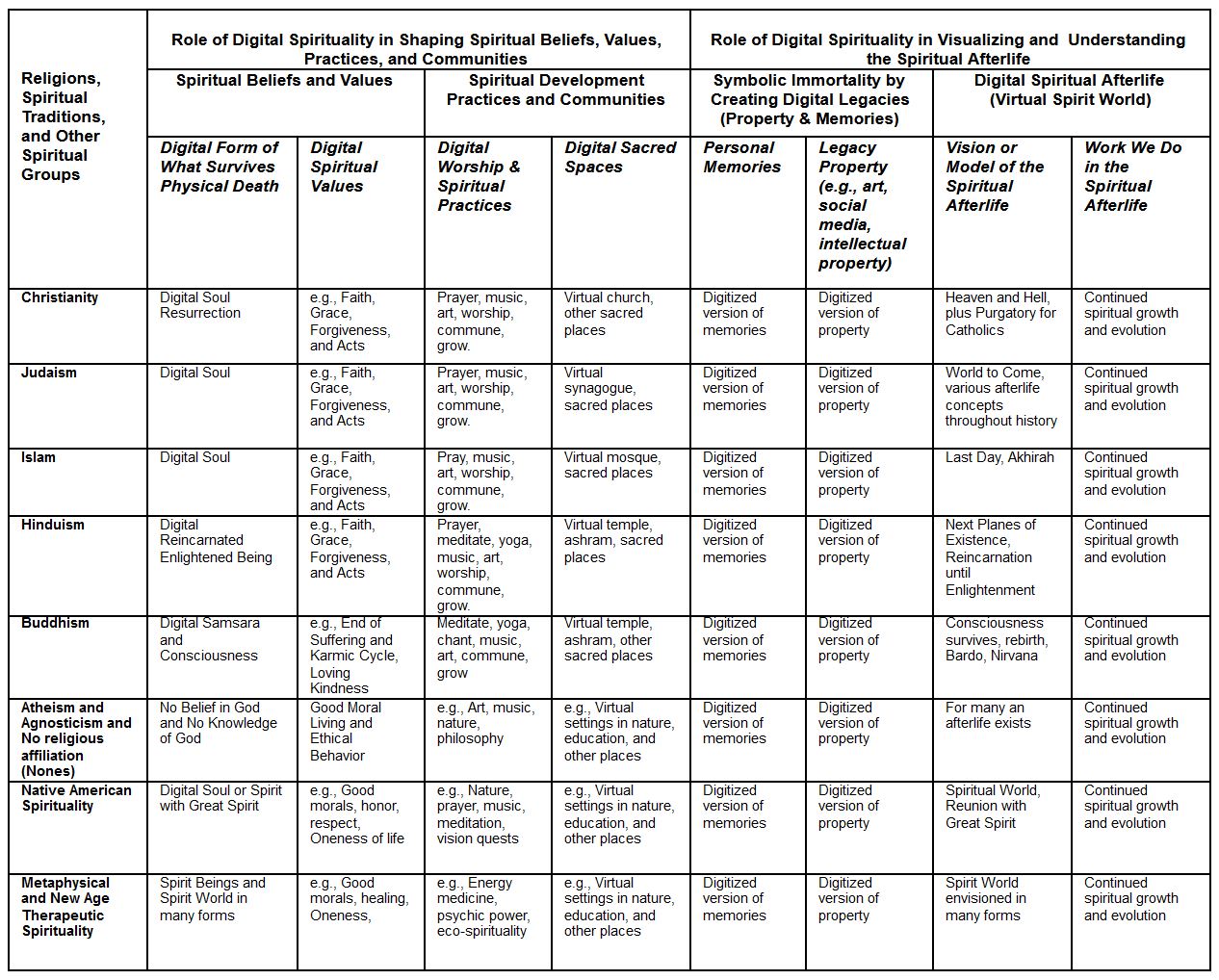The Two Faces of Digital Spirituality
Contrasting Motives for Digital Spirituality
My curiosity about digital spirituality is grounded in the view that technology, guided by the proper motivations, ethics, and knowledge, can contribute in meaningful ways to our individual and collective spiritual development. Depending upon how any technology is used, it can create either benefit or harm. History offers us many lessons about technology’s two-edged sword. For one, look to our uses of nuclear power. If digital spirituality is to do more good than harm, we must first understand our underlying motivations for exploring its role in our spiritual lives.
My research on the role of digital culture and technology (digitalism) in religion and spirituality offers a stark reminder that we need to choose wisely between two overall motivations for looking to technology as a tool for spiritual development. These two motivations represent the two faces of digital spirituality.
The first motivation says we should use digital technology to escape the human condition and its frailties, while the second motivation encourages us to look to digital technology to improve the human condition. Each tempts us in a different direction. The first is the choice to abandon humanity and its evolving spiritual foundation. The temptation here could be seen as “playing God,” or placing technology advancement over the advancement of the human spirit. The second is to use technology to consciously grow into our divine human nature, which I believe is the superior motivation. The second motivation invites us into a responsible co-creation relationship with the Divine, where we use digital technology to experience ourselves and our divinity in spiritually meaningful ways.
Digital spirituality is an emerging wave in many religions and spiritual traditions, where individuals and faith communities use digital culture and technology (digitalism) in a purposeful way to fulfill their religious and spiritual needs and aspirations. Very importantly, digital spirituality is about using technology with a spiritual intention
Brief Overview of the Religion-Technology Relationship
Technology and religion are no strangers to each other. Their relationship in the Western World can be traced back to the Middle Ages where the two emerged in the context of Christianity. Each has its roots in a form of transcendence. Religion and spirituality aim to transcend fallen human nature, illusion, and evil. Meanwhile, technology seeks to transcend nature, the human body’s frailties, and advance work and personal productivity. Throughout the history of religion, we see important roles played by technology. For example, the Gutenberg printing press, invented in 1440, gave the world the Gutenberg bible, which was instrumental to the Protestant Reformation in the 14th Century. In the 20th Century, radio and television extended the reach of religion across America and the world. In today’s world, we are witnessing the profound influence of the Internet and digital technology on religion and spirituality, which this article examines.
The Path of Digital Technology Through Religion and Spirituality
This article invites readers to look at the many forms and expressions of religion and spirituality across the world through the lens of digitalism, as it has increased its influence on religious and spiritual practice and belief, and how in the future it could transform our understanding of the human spirit and its afterlife.
Digital spirituality has emerged since the early 1990s as an unforeseen outcome of the use of digital tools and virtual environments by spiritual seekers and practitioners. In the past decade, we have made increasing use of mobile phone and tablet apps for spiritual practice and spiritual development, online places of worship (cyber-churches), virtual meditation and prayer groups, live-streaming of sermons and spiritual study groups, online baptisms, weddings, and funerals, virtual reality games and films about the spiritual afterlife, and many more things to come. Reliance on digital spirituality has grown markedly during the current COVID-19 Pandemic as physical places of worship were shuttered in many states to reduce the virus spread. My research indicates that an important, and to some people shocking, future use of artificial intelligence and virtual reality technologies will be to create cyberspaces enabling humans to experience and share their personal visions of the spiritual afterlife.
In addition, we are using the Internet increasingly to: 1) deliver degree and non-degree religious and spiritual education; 2) provide information and knowledge about religion and spirituality; 3) connect with others in virtual spiritual communities; 4) perform administrative functions related to church finances and membership support and development; and 5) market and distribute religious products and services to the global marketplace. In most cases, faith communities have borrowed and adapted these Internet uses from business, education, and government. It is important to mention that technology companies and entrepreneurs have played the major role in creating the digital technology products and services used by faith communities. Depending upon how far we are willing to take digital spirituality, these companies’ profits will either grow or plummet in the future.
Beyond the more routine administrative uses of digital technology, how might we visualize the emergence of digital spirituality in religions and spiritual traditions? Table 1 below provides a broad sketch of this emergence in two major related areas: 1) spiritual beliefs, practices, and communities; and 2) spiritual afterlife understanding.
Table 1: Emergence of Digital Spirituality in Selected World Religions and Spiritual Traditions1

Table 1 above includes a reference to symbolic immortality, which means that immortality is defined in terms of whether a deceased person is: 1) remembered; 2) the person’s beliefs and achievements live on; and 3) the person’s life continues to make a contribution beyond their lifespan. In other words, symbolic immortality is defined in terms of what a person cared about or was committed to in life. One example of symbolic immortality is making a large financial gift in the name of the donor to a religious group, arts organization, medical center, or educational institution. Literal immortality, on the other hand, suggests human beings escape death either by delaying it or by surviving the process of dying.2 Human longevity, as science tell us, hinges on genetics, lifestyle and standard of living, education, a clean environment, and other factors. The digital spiritual afterlife for now is seen as a form of symbolic immortality.
For now, the digital spiritual afterlife is a concept that suggests artificial intelligence and virtual reality technologies can be used in the future to create virtual environments allowing people to create, experience, and share their personal visions of the spiritual afterlife. It is seen as a tool that can be adapted for use in any religion or spiritual tradition with the intention of promoting spiritual awareness and growth. In time, the digital spiritual afterlife could include the development of digital replicas of human beings and their experiences and memories, including a digital soul or digital consciousness that inhabits the digital spiritual afterlife.
With this view of the path of digital spirituality through religions and spiritual traditions in mind, we turn to a vitally important question: Should we use advanced digital technologies with a spiritual development intention? For an answer, we return to the two central motivations for looking to technology for spiritual answers, which were discussed at the beginning of this article.
Where the First Face of Digital Spirituality Could Take Us
Should we use technology to consciously escape the human condition and its frailties, which could introduce the prospect that artificial intelligence (AI) agents could someday surpass humans in cognitive, emotional, and spiritual intelligence, attain literal immortality, and live forever in a digital after-world?
Transhumanism and its proponents, such as Ray Kurzweil, Max Moore, Nick Bostrom, and others, encourage us to consider the possibility that human beings may not represent the final stage of the evolutionary process.3 Several ethical issues and dilemmas are raised by this possibility, including major challenges to our long-held definition of personhood, or what it means to be a person. Personhood constitutes the union of the spiritual and the corporeal, which is considered to be the defining essence of human beings. Is our motivation to bring about personhood, including consciousness and spirit, to future AI agents? Most transhumanists seem to stop short of this recommendation. If we were to cross this line in giving consciousness and spiritual essence to AI agents, the mission of digital spirituality could shift in an alarming way to the cultivation of the spiritual life of AI agents, and cease to be about fostering human spiritual growth. This motivation did not underlie my recent book on digital spirituality.
The Second Face of Digital Spirituality: Prospects and Challenges
Having examined the potential frightening consequences of digital spirituality’s first face, let’s look at its second face, which keeps the focus of religion and spirituality in the virtual world on understanding and improving the human spiritual experience. In serving this worthy mission, digital spirituality will continue to evolve as its supporting technological foundation advances, and as the spiritual growth benefits of digital spirituality become better understood.
What are the challenges ahead? One challenge on the horizon is the integration of in-person (physical) and virtual spiritual beliefs and practices. A second challenge lies in using the digital world to advance our understanding of the spiritual afterlife in a way that prepares for better living in this world and readies us for our transition to the afterlife when our time comes. It is important that digital spirituality serves us by ensuring that whole-person spiritual development is cultivated in our virtual and physical worlds. Digital spirituality in this sense must deepen the human experience of spiritual oneness, and not add to our growing sense of isolation and fragmentation. Finally, it is important that our spiritual learning in the in-person and virtual worlds feed each other in a meaningful way with a focus on the mutual sustenance of the human spirit and Planet Earth.
References
[1] This table intends to provide a broad overview of beliefs and practices related to the spiritual afterlife. In reality, these beliefs and practices are quite diverse within religions and spiritual traditions.
[2] Iannone, Donald, T. Digital Spirituality, Its Rise and What It Means for Spiritual Identity, Belief, and Practice, Kindle Direct Publishing Company, Kendallville, Indiana, 2020.
[3] Transhumanism is a class of philosophies of life that seek the continuation and acceleration of the evolution of intelligent life beyond its currently human form and human limitations by means of science and technology, guided by life-promoting principles and values. Source: Moore, Max, “Transhumanism: Toward a Futurist Philosophy,” unpublished essay, 1990.







Accessing personalized digital spirituality is indeed a great balancing force in the ideal approach to technology as sacred tools. Which is already possible in our modern day world, but it takes a lot of work and self-led discovery in order to accomplish.
I am also an advocate for human enhancement through technology, tempered with spiritual wisdom. And hope that one day digital spirituality will be more widely recognized and embraced.